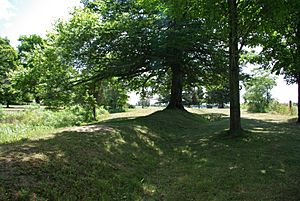Southwold Earthworks facts for kids
Quick facts for kids Southwold Earthworks |
|
|---|---|

Trees growing out of the remains of raised earthworks at the Southwold Earthworks site
|
|
| Location | Southwold, Ontario, Canada |
| Founded | Circa 1500 |
| Original use | Village site of the Neutral people |
| Current use | Archaeological site |
| Governing body | Parks Canada |
| Designated | 1923 |
The Southwold Earthworks is a special place in Ontario, Canada. It's what's left of an old village where the Neutral people lived a long time ago. They lived here between about 1450 and 1550 AD. This means it was before Europeans came to Canada.
You can find the entrance to the site on Iona Road. It's about three kilometres south of the town of Iona. The village was surrounded by two oval rings of raised earthworks. These were like big, low walls made of earth.
Contents
What Was the Southwold Village Like?
This ancient village was located in southwestern Ontario. It was near a small stream that flowed into Talbot Creek. The closest big town today is St. Thomas, Ontario.
Archaeologists are like history detectives. They have studied the site carefully. They found signs that there were about 18 longhouses inside the village. These longhouses were different sizes.
Who Were the Neutral People?
Historians believe that between 800 and 900 people lived in this village. These people were called the Attiwandaronk Indians. They spoke a language similar to the Iroquoian people.
French explorers later called them the "Neutrals." This was because they tried to stay neutral, or not pick sides, in conflicts between other Indigenous groups.
In the middle of the village, there was an open space. This area was probably used for activities or as a meeting place. The village was likely surrounded by a palisade. A palisade is a strong fence made of tall, pointed logs. It was built to protect the village.
How Were the Earthworks Built?
The Southwold village was about 0.8 hectares (2 acres) in size. It was completely circled by two rings of earthworks. These earthworks were the base for a double ring of upright pickets, or palisades.
The main entrance to the village was probably at the northeast side. There were also two other openings. One was in the northwest and another in the southern part. These openings allowed a small stream to flow through the palisades.
Why Is Southwold Earthworks Important?
The Southwold Earthworks is a very important historical site. It was one of the first places to be officially recognized in Canada. The Historic Sites and Monuments Board of Canada thought it was special.
In 1923, it was named a National Historic Site of Canada. This means it's a place of great historical importance to the country. The Canadian government bought the site in 1929 to protect it.
What Did Archaeologists Discover?
Archaeologists have studied the Southwold Earthworks twice. Once was in 1935, during the time of the Great Depression. The second time was in 1976.
What Do Local Stories Say?
The local Oneida community has their own stories about Southwold. Their oral traditions say that Southwold was a ceremonial site. This means it was used for special rituals or events.
According to these stories, the palisade was not for defense. Instead, it screened activities inside the village from people outside. The site might not have been a year-round village. It could have been a seasonal place for healing and purification rituals.
What Did Science Find?
Archaeologists found some interesting things about Southwold. It's on flat land, which is unusual for a village that needed defenses. Most villages built for protection were on hills.
Even though it had fortifications, there's no sign it was ever attacked. Also, even though many people could have lived there, archaeologists found little garbage. This is strange for a place where 800 people lived for a long time. These findings make the site even more mysterious and interesting!

